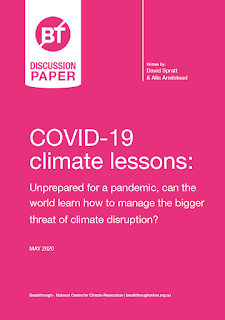 This post is the concluding section of a discussion paper, Covid-19 climate lessons, just published by the Breakthrough National Centre for Climate Restoration.
This post is the concluding section of a discussion paper, Covid-19 climate lessons, just published by the Breakthrough National Centre for Climate Restoration.
The novel coronavirus pandemic of 2020 has striking parallels with climate disruption. The threat was well known and catastrophic, even existential. History’s valuable lessons were ignored. Researchers were clear on what needed to be done, and how to respond. The UN had devoted a whole section to the issue, governments ran risk scenarios and national security analysts warned of the consequences. The developed world had the capacity to be ready. And to support less prosperous nations, or should have been. When it became fatal, it was conceived by wealthy nations as a threat somewhere else, because they were insulated. Then there was the denial, the delay, wanting to avoid any economic dislocation. Modern society was good at research, solutions would appear, no need to panic. Humans had tamed nature.
This description fits both cases. The pandemic is a dress rehearsal for climate change: “COVID-19 is climate on warp speed,” says Gernot Wagner, a climate economist at New York University and co-author of Climate Shock. The current pandemic is a foretaste of the shocks that the climate crisis could cause “to supply and demand, disruption of supply chains, and global transmission and amplification mechanisms”, according to McKinsey&Co analysis. Both are systemic, physical shocks that propagate fast in an interconnected world. They are regressive, non-stationery and risk multipliers, and can only be remedied by understanding and addressing the underlying physical causes. Both reflect the “tragedy of the commons” problems, in that individual actions can run counter to the collective good and deplete a precious, common resource. Climate change will increase the geographic range of infectious diseases and air pollution increases susceptibility to respiratory illness. The pandemic emergency teaches us valuable lessons about how to respond to the climate emergency:
- Moving into emergency mode, with fast change, is possible: a clear focus on the leading role of the state allowed a fast, innovative, society-wide mobilisation to face the threat, even after initial delays. Disruptive socio-economic shifts that would have been considered impossible have been experienced, and normalised.
- Leadership is decisive, including in changing public ideas: Political leadership, where it has been exhibited, and public sector competency, have made the difference between success and failure. Clear, nonpartisan messages that describe why it is fair and necessary to change behaviour, and explain government decisions, can produce public support for ideas that would in other times be considered radical and unacceptable.
- The public sector matters: the crisis is building understanding of the importance of a well- functioning, proactive government and state apparatus, and the disastrous consequences for public and health services of austerity and politicisation.
- People matter: Governments can decide that health and life is more important than the economy: the first duty of a government is to “protect the people”, and attempts to delay responding to the pandemic to avoid economic disruption made it worse, increasing the economic damage.
- Science matters: Sidelining expert opinion for political purposes or economic expediency was counterproductive. An ideological myopia in accepting expert advice costs lives and dollars.
- The precautionary principle should be applied. Problems which start out small, but have the potential to create systemic ruin, must be solved while they are small. Waiting to see if they become large is courting the very ruin we seek to avoid, says Kurt Cobb.
There are also big differences between pandemics and climate disruption. A pandemic is imminent with visceral danger; the climate threat may seem distant in time, even as damaging impacts occur. And a pandemic may be geographically contained, whereas climate risks are global. Pandemics impacts are discrete (individual) and patients may recover, vaccines can be developed and populations gain immunity, whereas climate risks are cumulative. Pandemics do not suffer the same degree of system-level feedbacks and interdependencies as the climate system. As well, it is only possible to act in response to a pandemic once it manifests, whereas if climate mitigation is not seriously enacted until the crisis is upon the world in full measure, then it is too late. Due to inertia in the global climate system, the impact of increasing atmospheric carbon concentrations from continuing fossil fuel use, modern agriculture and land clearing is not evident for years ahead. By the time those impacts become clear it will be far too late to act. With climate disruptions, we may reach a point — not too far away — when the “hothouse Earth” scenario is realised and interacting system feedbacks drive the Earth’s climate to a “point of no return”. There was a catastrophic failure of risk management in response to C19. An even more rigorous approach to existential risk management is necessary for climate disruption. But this is not happening:
- Existential risk management requires an objective look at the real risks with an emphasis on the fat-tail risks, but climate policymakers and the IPCC reports have failed to fully understand the existential nature of climate disruption. A trend towards “erring on the side of least drama” has emerged, yet “when the issue is the survival of civilisation is at stake, conventional means of analysis may become useless”, says Prof. Hans Joachim Schellnhuber.
- Normative targets within a moral framework have not been set. Policymakers adopt targets which will result in the destruction of the world’s coral systems, drown nations, and inundate agriculturally-important deltas and megacities. And their actions fall woefully short of their goals. The precautionary principle has not been applied in the face of threats that may cause systemic ruin.
- The world is sleepwalking towards disaster. The UN climate science and policymaking institutions are not fit-for-purpose and have never examined or reported on the existential risks. There are no national or global processes to ensure that such risk assessments are undertaken and are efficacious. The World Economic Forum reports on high-end global risks, including climate disruption, once a year and then everybody goes back to ignoring the real risks.
- Even as climate change impacts are being etched into the Earth’s surface, there is no coherent strategy with actions aligned to normative targets, and the establishment of institutions and practices to carry out that task.
If the first duty of government, and the international community, is to protect the people, then the focus must be on the biggest threats. Existential risk reduction is more important than any goal, and a first, urgent step is for governments to recognise this need, understand the existential climate threat, and take the commensurate actions — even though they will be disruptive — before it is too late.
Emergency brake feature image via Reimund Bertrams from Pixabay





